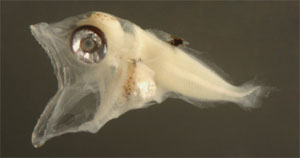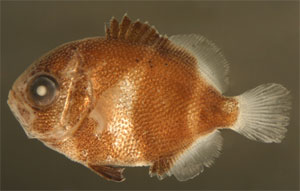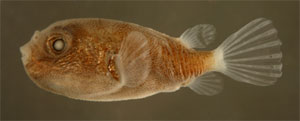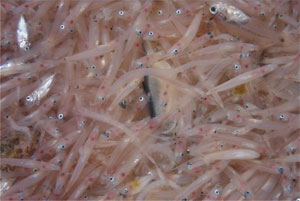New online photographic guide to coral reef fish larvae unlocks secrets of young fish
Coralreeffish.com release
December 13, 2005
Coralreeffish.com, a coral reef fish research site, today announced the availability of a photographic web-guide to the late-stage larvae of coral reef fishes. The guide is aimed at both assisting researchers in identifying the myriad fish larvae that are caught in reef surveys and providing an overview of this intriguing, and often invisible, world to students and interested laymen.
“Virtually all published descriptions of larval fishes are long and technical and illustrated with line drawings” says Benjamin Victor, founder of the site, “I thought that, in this web-age, lively photographs are the way to go.”
   
Selected images from Coralreeffish.com. |
The guide will be comprehensive and is starting with the Caribbean fauna, where the number of fish species is not overwhelming- a few hundred vs. thousands in the Indo-Pacific. This allows most larval fishes to be identified down to species. Victor is photographing his large larval fish collection from the San Blas Islands of Panama, as well as other collections from Belize and Barbados. In addition, Victor is recruiting a variety of DNA labs to apply the latest DNA-sequencing technology to identify larvae in some groups with numerous species.
Coral reef fish larvae are pelagic: they spend from a couple of weeks to many months in open ocean waters before returning to the reef to settle down for the rest of their lives. Around the time of settlement, reef fish larvae begin to undergo a profound transition, or metamorphosis, in preparation for settlement (“recruitment” or “replenishment” in population biology terms). The guide will focus on these later stages that are little known and rarely illustrated.
The plan is to then move on to the tropical eastern Pacific which has almost as many species but is essentially terra incognita for larval reef fish biology. Collections from Baja California, the Bay of Panama, and the Galapagos Islands will be included. This guide should become an essential resource for students of the larval biology of fishes.
Links:
A guide to the late-stage fish larvae of the Caribbean
Coralreeffish.com
Related articles
Coral reefs decimated by 2050, Great Barrier Reef’s coral 95% dead
Australia’s Great Barrier Reef could lose 95 percent of its living coral by 2050 should ocean temperatures increase by the 1.5 degrees Celsius projected by climate scientists. The startling and controversial prediction, made last year in a report commissioned by the World Worldwide Fund for Nature (WWF) and the Queensland government, is just one of the dire scenarios forecast for reefs in the near future. The degradation and possible disappearance of these ecosystems would have profound socioeconomic ramifications as well as ecological impacts says Ove Hoegh-Guldberg, head of the University of Queensland’s Centre for Marine Studies.
Recordings of coral reef sounds attract fish
According to an international team of researchers based in Australia’s Great Barrier Reef, using recordings of reef sounds may increase reef fish stocks depleted by shipping traffic, underwater drilling and overfishing. Scientists have discovered that some species of young coral reef fish are lured back to home reefs by sounds they hear while still developing in the egg. By piping in convincing reef music,’ consisting of recorded fish and shrimp noises through underwater speakers, marine biologists have been able to attract reef fish to artificial reefs to start new colonies. In the future, researchers hope to employ the same tactics to lead young reef fish to natural reefs where fish stocks have been decreased by outside factors or to populate newly established conservation areas.
Coral, Coiba and the Next Big Thing. Bioprospecting in Panama
The largest island off the Central American Pacific coast may be hiding big secrets in its reefs, among them, a possible cure for malaria. Coiba, an island 12 miles off the coast of Panama and once a notorious penal colony, is poised on the brink of transition and transformation. The 10-mile wide and 30-mile long island possesses a unique ecology that may host potential drugs for treating numerous ills. The future of Coiba depends on how its resources are managed by the government.
Dubai’s artificial islands have high environmental cost
While there have been numerous articles written recently about the proliferation of artificial island projects, the astounding “The World” venture among them, few have addressed or assessed the environmental impact of such massive undertakings and the transformation of both the sea and landscape. Until recently, Nakheel, the government-controlled corporation developing these ambitious projects, has been able to focus predominantly on promoting rather than defending the islands, but new evidence of environmental detriment is bringing the company and its projects under fire from certain groups.